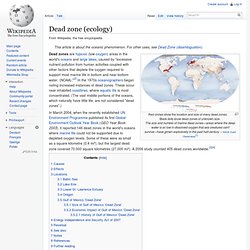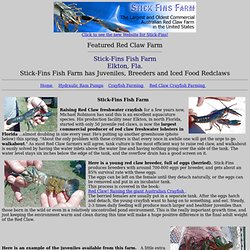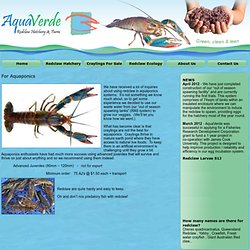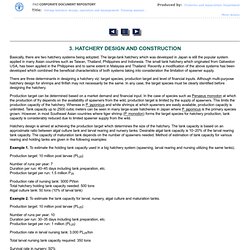

Dead zone (ecology) Red circles show the location and size of many dead zones.

Black dots show dead zones of unknown size.The size and number of marine dead zones—areas where the deep water is so low in dissolved oxygen that sea creatures can't survive—have grown explosively in the past half-century. – NASA Earth Observatory[1] In March 2004, when the recently established UN Environment Programme published its first Global Environment Outlook Year Book (GEO Year Book 2003), it reported 146 dead zones in the world's oceans where marine life could not be supported due to depleted oxygen levels. Some of these were as small as a square kilometre (0.4 mi²), but the largest dead zone covered 70,000 square kilometres (27,000 mi²).
A 2008 study counted 405 dead zones worldwide.[3][4] Climate has a significant impact on the growth and decline of ecological dead zones. Internationally celebrated limnologist Dr. Additionally, natural oceanographic phenomena can cause deoxygenation of parts of the water column. Stick-Fins Red Claw Farm, Elkton, Fla. Stick-Fins Fish Farm Raising Red Claw freshwater crayfish for a few years now, Michael Robinson has said this is an excellent aquacuture species.

His production facility near Elkton, in north Florida, started with only 50 juvenile red claws, is now the largest commercial producer of red claw freshwater lobsters in Florida ...almost doubling in size every year. He's putting up another greenhouse (photo below) this spring. "About the only problem with these critters is that every once in awhile one will get the urge to go walkabout. " As most Red Claw farmers will agree, tank culture is the most efficient way to raise red claw, and walkabout is easily solved by having the water inlets above the water line and having nothing going over the side of the tank.
Here is a young red claw breeder, full of eggs (berried). Here is an example of the juveniles available from this farm. As you can see above, Michael used an inexpensive but very efficient method for his Red Claw production. Redclaw Hatchery & Farm - AquaVerde - Atherton Tablelands, Queensland, Australia - FOR AQUAPONICS. We have received a lot of inquiries about using redclaw in aquaponics systems.

It’s not something we know much about, so to get some experience we decided to use our waste water from our “out of season spawning tanks” (RAS system) to grow our veggies. (We’ll let you know how we went.) What has become clear is that craylings are not the best for aquaponics. Craylings thrive in mature earth pond where they have access to natural live foods. To keep them in an artificial environment is challenging until they grow a bit. Advanced Juveniles (80mm – 120mm) - not for export Minimum order: 75 AJ’s @ $1.50 each + transport Redclaw are quite hardy and easy to keep. Oh and don’t mix predatory fish with redclaw! Shrimp Hatchery Design, Operation and Management. Basically, there are two hatchery systems being adopted.

The large-tank hatchery which was developed in Japan is still the popular system applied in many Asian countries such as Taiwan, Thailand, Philippines and Indonesia. The small tank hatchery which originated from Galveston USA, has been applied in the Philippines and to same extent in Malaysia and Thailand. Recently a modification of the above systems has been developed which combined the beneficial characteristics of both systems taking into consideration the limitation of spawner supply. There are three determinants in designing a hatchery viz: target species, production target and level of financial inputs. Although multi-purpose hatchery design for shrimps and finfish may not necessarily be the same. Production target can be determined based on a market demand and financial input.
Hatchery design is aimed at achieving the production target which determines the size of the hatchery. Example 1. Example 2. Or 3.1 Size of hatchery.